Earthlearningidea, a website for geoscience educators, recorded its first two million activity downloads this year, writes Chris King*.
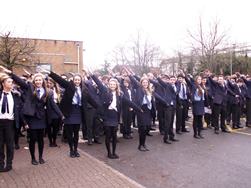 Little did we realise, when a bid for funding from the UN International Year of Planet Earth was turned down, that such a successful phoenix could arise from its ashes. It led us to wonder what else we could do during the International Year - without funding - and we developed the idea of publishing one new geoscience education activity, online, in each of its weeks.
Little did we realise, when a bid for funding from the UN International Year of Planet Earth was turned down, that such a successful phoenix could arise from its ashes. It led us to wonder what else we could do during the International Year - without funding - and we developed the idea of publishing one new geoscience education activity, online, in each of its weeks.
Thus, during the year, three of us (working on a voluntary basis) published 52 Earth-science teaching activities, aimed at teachers and classrooms with minimal resources, since our initial target audience was teachers in the developing world. This was so successful that we have continued to publish activities (at the rate of one every two weeks) ever since.
Image: Human magnets, showing magnetic inclination at the UK latitude. Photo, Abigail Brown
During the International Year (2007, though like all things geological, the UN Year actually lasted longer than that, from 2006 to 2008), a colleague from Argentina asked if he could translate the activities into Spanish. We welcomed this, and thus Spanish Earthlearningideas were added to the website. This was the beginning of the Earthlearningidea translations which followed. (Stop press: A Danish colleague has just offered to translate Earthlearningideas into Danish and Greenlandic (the Eskimo–Aleut language spoken by about 57,000 Greenlandic Inuit people. )
Developed
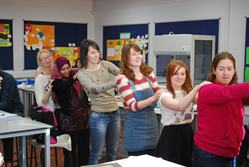 It soon became clear that, despite our IYPE-inspired intention, most users of Earthlearningideas were living in the more developed world – and particularly the USA. So we decided to broaden our repertoire to include Earthlearningidea + (‘ELI plus’) activities, requiring either slightly more sophisticated equipment (as found in normal school science labs) or more abstract thinking than our original Earthlearningideas. Later we also added Earthlearningideas for teaching ‘early years’ pupils.
It soon became clear that, despite our IYPE-inspired intention, most users of Earthlearningideas were living in the more developed world – and particularly the USA. So we decided to broaden our repertoire to include Earthlearningidea + (‘ELI plus’) activities, requiring either slightly more sophisticated equipment (as found in normal school science labs) or more abstract thinking than our original Earthlearningideas. Later we also added Earthlearningideas for teaching ‘early years’ pupils.
Image: Human molecules demonstrating S-waves in a ‘solid’. Photo, Peter Kennett.
The success of Earthlearningidea can be summarised by these figures, from July 2015:
- 2,071,954 pdf downloads of Earthlearningideas so far (not including the separate websites set up to disseminate Earthlearningideas in different languages, such as Portuguese, German and Polish)
- 47,560 mean number of pdf downloads per month in 2015
- 212 Earthlearningidea activities published in English
- 607 translations from English by December 2014, into 10 other languages, Spanish, Catalan, Portuguese, Norwegian, Italian, German, Polish, South Korean and one in Tamil
- 25GB of download data per month
- 195 countries and 9669 cities and towns in which the Earthlearningidea blog has been accessed
- 10 top countries, in order:
- United States
- United Kingdom
- India
- Canada
- Spain
- Australia
- Italy
- Philippines
- Germany
- New Zealand
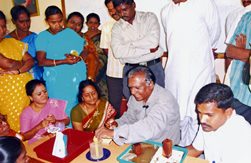 Image: Earthlearningideas in use in India. Photo Jothi Rajan.
Image: Earthlearningideas in use in India. Photo Jothi Rajan.
Each Earthlearningidea activity is published as a free-standing activity with supporting photographs and diagrams. The activity is followed by a ‘Back up’ section containing teaching information including the context in which the activity could be taught, the ‘answers’, underlying scientific principles, pupil learning outcomes, age range, timing and resource list, how thinking skills can be developed through the activity, follow-up work, useful links and the source of each idea.
Most ideas are practical ‘hands-on’ activities, but some are thought experiments, others are card sorts, some are aimed at fieldwork and so on. Many were originally published in Earth Science Teachers’ Association (ESTA) publications or in Earth Science Education Unit (ESEU) workshops; but activities have also been culled from a wide range of resources, while others were especially devised for the website. Many people have contributed, and a further 50 activities are currently in preparation.
Success
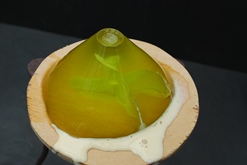 To what can the unexpected success of an activity, initially generated by three people working on a voluntary basis, from their own homes be attributed? We don’t know. This may seem counterintuitive, but it could be that there is great power in voluntary work. Since we receive no income, we can ask people across the world to publicise and use our work and even to translate the ideas, for exactly the same as we get paid ourselves, i.e. ‘nothing’! Colleagues everywhere, particularly members of the International Geoscience Education Organisation (IGEO), have responded wonderfully positively - and it is surely no accident that Earthlearningidea is most successful in countries with active IGEO members.
To what can the unexpected success of an activity, initially generated by three people working on a voluntary basis, from their own homes be attributed? We don’t know. This may seem counterintuitive, but it could be that there is great power in voluntary work. Since we receive no income, we can ask people across the world to publicise and use our work and even to translate the ideas, for exactly the same as we get paid ourselves, i.e. ‘nothing’! Colleagues everywhere, particularly members of the International Geoscience Education Organisation (IGEO), have responded wonderfully positively - and it is surely no accident that Earthlearningidea is most successful in countries with active IGEO members.
Image: Jelly volcano with cream dykes. Photo, Peter Kennett.
Other reasons may be:
- By adding a new activity to the website each fortnight, with email alerts, generated through email, the ELI blog, Facebook and Twitter, people across the world are sent regular Earthlearningidea updates.
- Each activity is written in accessible English with simple resources, and so can be easily incorporated into teaching Schemes of Work.
- Many Earthlearningideas are deliberately innovative, presenting Earth science in dynamic, interesting and engaging ways that have the potential to fire the enthusiasm of teachers and pupils alike.
- An effective search engine ensures that ideas available for different topics are easily found on the website.
- Lists of ‘Children’s Fun Session’ for use by any enthusiastic geologist in family days or in museums.
- Lists of activities for different teaching strategies.
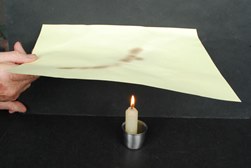 Whatever the reasons, the year-on-year increase of pdf downloads clearly deomstrates Earthlearningidea’s popularity across the world.
Whatever the reasons, the year-on-year increase of pdf downloads clearly deomstrates Earthlearningidea’s popularity across the world.
This initial bid to the International Year of Planet Earth for funding was to present UK-style Earth Science Education Unit workshops as professional development to teachers in certain countries around the world. The failure of that bid has caused Earthlearningideas to be used as the basis of teacher education workshops in many more countries around the world than originally envisaged – another unexpected bonus.
So, how can Geoscientist readers help?
Recent Earthlearningidea examples
- Fieldwork: the ‘All powerful’ strategy: discussing geological histories in imaginative ways
- Continental split – the opening of the Atlantic Ocean: modelling how the continents moved, from Pangaea to today
- Journey to the centre of the Earth – on a toilet roll: just how thin is the crust we live on?
- Sink hole!: demonstrate sink hole processes in action
- How many Beany Beetles? - the evolution game: investigating evolution by adaptation and natural selection
- A screaming roller coaster: How fast am I travelling (due to Earth’s spin and Earth’s orbit)?
- Smelter on a stick: smelting iron ore to iron on a gas burner
- Running the fossilisation film backwards: bringing a fossil ‘back to life’
|
First, you can pass information about Earthlearningidea (http://www.earthlearningidea.com) to all the geoscience educators you know worldwide, as well as to science and geography teachers teaching Earth science topics.
If you are running a family day or visiting a school to give a talk, please mine the Earthlearningidea website for ideas to give your presentation extra added oomph.
If you have a simple idea of your own that you would like to share more widely, please let us know. If indeed it is suitable, we’ll be happy to publish it as a future Earthlearningidea.
* Chris King (Keele University), with Peter Kennett and Elizabeth Devon. E:
[email protected] http://www.earthlearningidea.com
Acknowledgements
- José Sellés Martínez - Argentina
- Merethe Frøyland, Kari Beate Remmen and Anne Kristine Byhring - Norway
- Roberto Greco, Barbara Scapellato, Claudio Casali, Bovino Miria, Sonia Manaresi, Giulia Realdon, Laura Agostini, Paola Fregni, Chiara Fioroni, Mauro Marchetti, Maddalena Macario, Lorenzo Lancellotti, Eleonora Paris and Nicoletta Scattolin - Italy
- Dirk Felzmann, Julia Brinkmann, Florian Wetzel, Silke Rönnebeck, Sylvia Brink and Kai Frings – Germany
- Celso Dal Ré Carneiro, Nádia C. M. Hoffman, Gustavo H. Teramatsu and Roberto Greco - Brazil
- Xavier Juan – Spain and Catalonia
- Pawel Wolniewicz - Poland
- Shao Yanxiu, Zhang Lianhai and Julia Yuan – China
- Michael Anjello Jothi Rajan - India
- IUGS-COGE - International Union of Geological Sciences - Commission on Geoscience Education: for an unsolicited donation of US$1000 for the development of this project in 2008.
- The Applied and Environmental Geophysics Research Group at Keele University for their generosity in hosting the Earthlearningidea website from November 2008 to July 2014 free of charge.
- Geologists’ Association, Curry Fund for a grant to host the website on a dedicated server from July 2014.